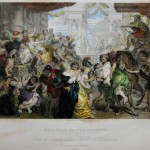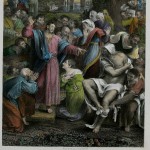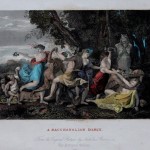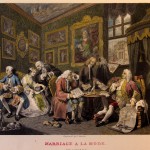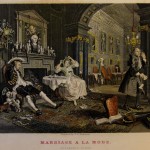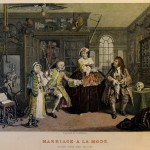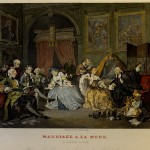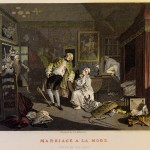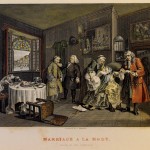- Rape of the Sabine women after Peter Paul Rubens. Published by Jones & Co 1840 12 x 16 cm (4 x 6 inches)
- Raising of Lazarus after Sebastiano del Piombo 17 x 12 cm (6 x 4 inches) Published by Jones & co 1840 It is interesting to note that this engraving was mis-attributed to Michelangelo in 1840
- A Bacchanalian Dance, after Poussin
This famous series by Hogarth, Marriage a la Mode, is full of interesting details much of whose significance were more apparent to the 18th & early 19th century viewer than they are to us today. See captions for a brief description. All 6 engravings are about 12 x 16 cm (4 x 6 inches)
- To the right, the nobleman points to his genealogical tree which roots in William, Duke of Normandy & conqueror of England. To the far left, the son who is to be married shows his bride-to-be his back as he admires himself in a mirror—indifferent to her as he displays his gold snuff box. Beside her, the lawyer, Counsellor Silvertongue. Two dogs chained together in the corner reflect the disinclination with which the young couple enter into their loveless marriage vows. A servant stands at the table where the gout-ridden patriarch sits, with a hand-full of unpaid bills that show the dissolution of the aristocratic family’s fortunes.
- The husband, a Viscount, just returned from a night out (candles burning low though it is daytime) is indifferent to the evidence that his wife has taken a lover (her open-legged pose implies) during the all-night party which has just broken up. A broken sword on the husband’s right shows he’s been in a fight. Out of his pocket hangs a female cap which the dog sniffs at. The old family servant is scandalized & his hand is full of unpaid bills with just one receipt intimating the bad faith upon which people of quality take on debt.
- The Viscount visits a quack &, lifting his cane in threat, complains of the Mercury pills’ inefficacy in treating his venereal disease. The young woman to his left is a prostitute who shows the viewer that she has Syphilis by dabbing at her lips with a handkerchief—sores that are the first symptom of the disease. The procuress who stands behind the charlatan unclasps a knife as if to protect her honour from the Viscount’s accusations of deception. The ‘unicorn’ horn (Narwhal) & broken comb suggest the ‘doctor’s’ real profession is barber.
- The Viscount’s father dead, his wife becomes Countess. Vain of her new status she dedicates herself to frivolous entertainment & neglects her domestic duties. The corral on the back of her chair indicates she has become a mother, though her child is nowhere to be seen. As the Countess attends her toilette, her back to her guests, an Italian singer receives rapt attention from two of the distinguished guests. The advocate lolling like a Roman on the couch, points to a folding screen on which is painted a revel as he holds out an admission ticket, implying that he, her paramour, is making a date with her for the evening. A Swiss servant dresses her hair & a black footman serves chocolate leering at the singer while the woman in the centre swoons at the song. The black child to the right points to the horns on a statue of Acteon, making reference to the cuckolded Viscount. The paintings are meant as indelicate subjects of erotic scenes: Lot & his daughters; The rape of Ganymede; Jupiter & Io.
- The Viscount, suspecting his wife’s infidelity, follows her to the masquerade the advocate invited her to in the previous plate. He bursts in, attacks, but s mortally wounded by the advocate, who we see escaping out a window. She, shamed, begs his forgiveness as he dies. Alerted by the sounds of fighting, the neighbours call the brothel owner’s attention—who can be seen ushering in a constable. On the wall behind, is painted Solomon’s judgement; a soldier, sword raised, threatens to slice the dangling baby in half. To the right, partially obscuring, the mural, a painting of Diana from which protrude below the massive legs of a Jewish soldier that appear to be her own.
- When the Countess is reproached by family & society, she returns to her father’s house & commits suicide with poison—she bribes her father’s servant to get her a dose of Laudanum (opium). Next to the empty vial that lies on the floor, Hogarth paints Counsellor Silvertongue’s last speech, intimating that he, too, has met a bad end. As she dies, her father cooly removes her wedding rings.
